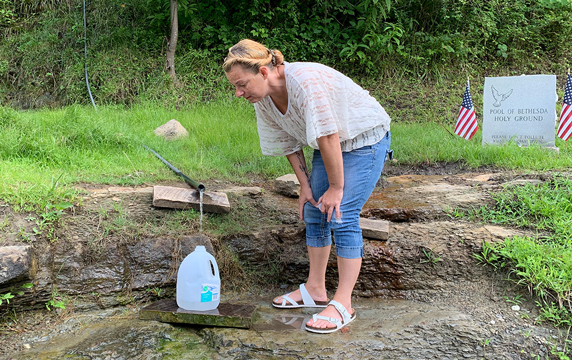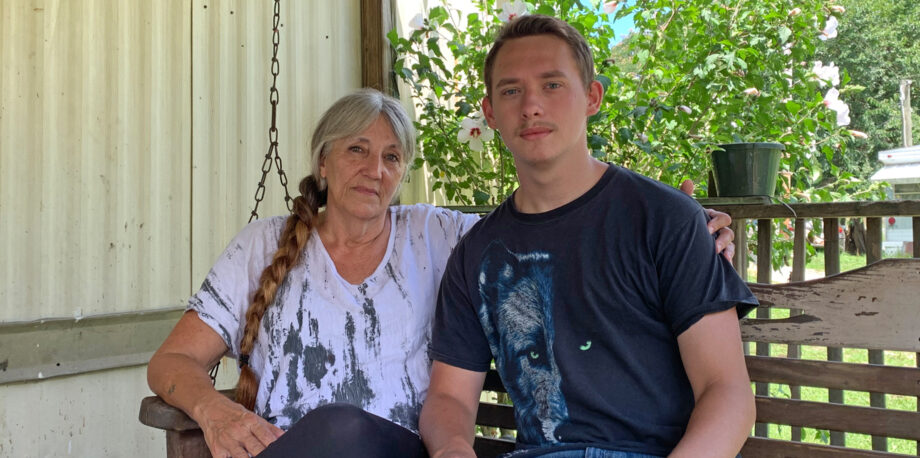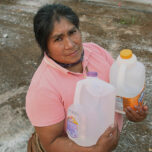September 23, 2020 — Editor’s note: This feature is republished with permission from The Guardian US.
 Florene Reed always makes sure there’s enough bottled water for her teenaged grandson, even if that means making do with tap water herself that causes a burning sensation in her stomach.
Florene Reed always makes sure there’s enough bottled water for her teenaged grandson, even if that means making do with tap water herself that causes a burning sensation in her stomach.
Reed grew up drinking the crystalline water from wells and local springs dotted throughout the Appalachian mountains in Martin County, but switched to bottled while raising her own family amid safety fears linked to coal mining and mismanagement at the utility.
She’s not alone: 96% of residents rely primarily on bottled water for drinking, and only 56% use tap water for cooking, according to a recent study by the University of Kentucky.
The tap water smells strongly of chlorine, like a swimming pool, and residents frequently report problems with bad taste, discoloration, sediment and irritated or burning skin after bathing.
“In Martin County nobody drinks the tap water unless they have to, you can’t trust it, and you can’t trust the water department,” says Reed, a former teacher’s assistant who lives off US$780 a month in benefits.
Reed ostensibly pays two water bills: US$60 to US$70 a month to the public utility and US$30 or so to the store for bottled water. Her grandson Chance Crum, 18, has never tasted the tap water.
“It makes you sick to my stomach,” says Reed. “I would never let my baby drink it, it smells bad and it tastes bad. It’s nasty, but sometimes I have no choice.”
This deep mistrust, residents and advocates say, is a legacy of how the water infrastructure has been neglected and mismanaged for years.
System in Disarray
Martin County in southeastern rural Kentucky is one of the poorest in America, with almost 40% of its estimated 12,000, mostly white, residents living in poverty and high rates of opioid addiction.
It was once the heart of American booming coal industry, but all that’s left now are a handful of mines, property empires belonging to former coal barons and the meandering freight train that now mostly transports consumer goods.
The county’s water problems first came into sharp focus — and were exacerbated — in October 2000 when a local coal company spilled 300 million gallons (1.16 billion liters) of coal slurry containing high concentrations of arsenic and mercury into nearby waterways.
At the time, it was the worst environmental catastrophe in the southeastern United States, but the Bush administration, under the leadership of the labor secretary Elaine Chao (wife of longstanding Kentucky senator Mitch McConnell), was accused of whitewashing the federal investigation by advocates and experts.
In the wake of the disaster, regulators found the water system in disarray and recommended root and branch reforms to fix the broken infrastructure and management system.
Rural water systems face unique challenges in providing clean, safe, affordable, sustainable drinking water, including difficult terrain and a lack of financial stability and expertise. Yet over the next two decades, the utility failed to invest in crucial water infrastructure while doubling its service network in an ad hoc manner — largely to households whose private wells were contaminated by coal mining.
The result: a network of hodgepodge pipes and pumps caused frequent line breaks and outages, forcing schools to be suspended and residents to boil water for safety. Line breaks risk contaminants, including harmful bacteria, entering the system, and residents regularly report brown earthy water.
Rural water systems face unique challenges in providing clean, safe, affordable, sustainable drinking water, including difficult terrain and a lack of financial stability and expertise. About 97% of the country’s 153,000 public drinking water systems serve 10,000 people or less.
But Martin County’s water crisis is just one consequence of a deep-seated local economic and political power system mired in small-town mismanagement that includes alleged patronage, self-dealing and corruption that advocates say has obstructed investment in crucial water infrastructure.
Residents are angry that local officials have authorized construction of an ostentatious government building in the county seat Inez, costing US$50,000 a month in repayments until 2038. While currently paid using coal severance funds, the burden may soon fall on local taxpayers, as Kentucky’s coal industry is rapidly declining.

This algae-ridden reservoir provides drinking water for Martin County residents. Photo courtesy of Nina Lakhani | The Guardian
Meanwhile, the algae-ridden reservoir is littered with empty liquor bottles and used syringes, and only one of the three water clarifying tanks is fully functional — though a grant has now been secured to fix this. The surrounding landscape is blighted by boarded-up stores, rundown trailer parks and signs advertising drug treatment centers.
Water Warriors
In 2016, a grassroots group called Martin County Water Warriors was created after the Flint scandal made headlines, and community members began sharing photos and stories about leaks, contamination and outages. A second group, Martin County Concerned Citizens, persuaded the state regulator (Kentucky Public Service Commission, or PSC) to give ordinary citizens a role in holding the water department accountable.
The entire water board resigned in protest over the increased oversight at the end of 2017, leaving the utility saddled with US$1.1 million debt.
In early 2018, the new board inherited a system on the brink of collapse: The utility was losing US$100,000 a month, and sought to increase rates by 49.5%. The following day, half the county lost its water supply, leaving some folks without water for three weeks.
In the end, the PSC approved a 42% hike, leaving one of Kentucky’s poorest counties with the fifth most expensive water rates in the state.
“The water district has always been part of the corrupt old boy’s system, where certain people and businesses got away with stuff without paying their fair share, while the majority were left paying for water they can’t even drink,” says Nina McCoy, a retired biology teacher turned water advocate from Concerned Citizens.
“People are still worried about the safety of the water, and that’s legitimate, but the biggest problem is affordability,” adds McCoy.
Nationwide, millions of ordinary Americans are facing rising and unaffordable bills for running water and risk being disconnected or losing their homes if they cannot pay, a landmark Guardian investigation found.
And bills look set to become even less affordable.
In January 2020, Alliance Water Resources, a private company that also runs rural utilities in Tennessee, Missouri and Iowa, took over day-to-day operations of Martin County’s beleaguered water department in a contract worth US$160,000 a month.
Almost everything — the pipes, treatment plant, polluted reservoir and billing system — needs overhauling after decades of neglect. Federal funding for water systems has declined by 77% since 1977.
“It’s a constant battle, like putting out fires, but now we are fixing things and have a systematic plan to maintenance as opposed to a band aid approach,” says Craig Miller, Alliance Water’s division manager.
Repairs and reconnections are happening faster, but the dilapidated system continues to hemorrhage water and cash.
In June, 71% of treated water was leaked before it reached a tap, and the utility lost almost US$50,000, according to figures Alliance presented at July’s public board meeting. The current debt stands at about US$750,000.
“Water is a human right, but clean water is not, it costs money, someone has to pay for it.” – Craig MillerA new billing system has already resulted in substantially higher charges for some residents, including bills higher than US$300 in July. A universal price hike is almost certain next year.
“Water is a human right, but clean water is not, it costs money, someone has to pay for it,” says Miller. “The fact is, revenues are not covering costs. Disconnecting people is an effective deterrent, absolutely.”
Miller claims water theft is “rampant” in the community. As a result, anyone caught siphoning water twice now faces disconnection and a lifetime ban — an extraordinarily punitive deterrent condemned by advocates.
“We’re very concerned about a rate hike before improvements in quality and leaks are seen, and when affordability is already a major issue,” says Mary Cromer, attorney at Appalachian Citizens’ Law Center and co-author of a 2019 report on the affordability crisis.
According to a study, private water companies charge on average 59% more than public utilities.
Alarming Results
Overall, grassroots activism has forced greater transparency and accountability from the utility, but most people still do not trust the water.
To address this, the University of Kentucky’s Center for Appalachian Research in Environmental Science designed a citizen-science study in which trained community members obtained tap water samples from 97 households throughout 2019.
The results were alarming: Almost half the samples had at least one contaminant that violated at least one U.S. Environmental Protection Agency (EPA) standard. The main health concern was unsafe levels of disinfection byproducts (DBP) — specifically total trihaloacetic acids and total trihalomethanes — which are associated with certain cancers and birth defects.
DBPs are formed by the reaction between chlorine added during the treatment process — which is necessary to kill harmful bacteria — and organic material found in raw water and inadequately flushed pipes.
But the EPA has reported zero DBP violations in Martin County since 2018. That’s when the EPA, which bases its calculation on the annual average of concentrations from quarterly samples, halved its collection sites to just two.
In addition, coliform bacteria were detected in 13% of the samples, indicating the possible presence of harmful bacteria.
While the study did not analyze every possible contaminant, toxic metals linked to coal waste were not present in high quantities.

BarbiAnn Maynard, a citizen water advocate, collects spring water at the Pool of Bethesda in Mingo County, West Virginia. Maynard uses the water for drinking and cooking because she doesn’t trust Martin County’s tap water. Photo courtesy of Nina Lakhani | The Guardian
Steps can be taken to reduce DBPs. Yet even before the results were published, Miller, of Alliance Water, and Jimmy Kerr, president of the water board, had dismissed the findings — claiming an insider had blown the whistle on sample collection irregularities.
“Water quality hasn’t been an issue for two years, but there’s inaccurate data and people out there who have an agenda. This is about perception and education,” says Miller.
Not so, says lead researcher Jason Unrine: “We followed all EPA protocols and the samples were analyzed in state accredited labs.”
Kerr, who claims his children drink the tap water, said the study distracted from the progress being made. “It’s frustrating that the advocates are trying to pull us back in the wrong direction, it’s a completely different district now, the data is old. But a few people think they are the next Erin Brockovich. … The easiest thing is fixing pipes, the hardest will be getting people’s trust back.”
BarbiAnn Maynard, an outspoken activist with Water Warriors who drinks and cooks with spring water, says: “The board call me a ‘lovable pain in the ass,’ but that’s fine, we’re forcing them to do their jobs. Just because Martin County is poor, isolated and rural, doesn’t mean we’re not important. We deserve affordable clean water, too.”
Related Posts
Ensia shares solutions-focused stories free of charge through our online magazine and partner media. That means audiences around the world have ready access to stories that can — and do — help them shape a better future. If you value our work, please show your support today.
Yes, I'll support Ensia!




